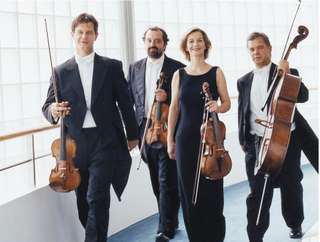|
Back
Sibling Love New York
92nd Street Y
04/29/2010 -
Ludwig van Beethoven: String Quartet in E minor, Opus 59, No. 2
Anton Webern: Five Pieces for String Quartet, Opus 5
Edvard Grieg: String Quartet in G minor, Opus 27
The Hagen Quartet: Lukas Hagen, Rainer Schmidt (Violins), Veronika Hagen (Viola), Clemens Hagen (Cello)

The Hagen Quartet (© Regina Recht)
If sibling rivalry ever disrupts the careers of the Hagen Quartet, it never shows up in the music. The two brothers and one sister have been performing worldwide and recording for Deutsche Grammophon for over a quarter of a century, and one can’t imagine them having any arguments except over rubati, repeats or renditions.
Yet I may be wrong. The four players (including second violin Rainier Schmidt) took each of the three pieces with an unrelenting aggression. One soon accustoms oneself to this pointed, vivid playing, so the slow movements (especially in the Grieg String Quartet) appear like interlopers amidst the duels of the players.
For the most part, this was all to the good. One could ignore the less-than-mysterious opening of the Beethoven 9th Quartet, since the following Allegro was performed with a frenzied vigor. One could hardly call the Molto adagio “vigorous”, but the Hagen Quartet continued the rhythmic thrust into the very depths of the movement, with some ravishing solo passages by First Violin Lukas Hagen.
All in the Hagen performance led to that rollicking finale, played not only Presto, but as if the Hagen were all running out to grab the last glass of wine. Yet this was a defiant performance, the fugatos and rondo themes tumbling over each other, as if to say, “Well, Beethoven wanted it presto, so we’ll show him what presto really sounds like.”
To finish the first half, Webern’s Five Movements were–dare I say it?–entertaining. In fact, the opening movement was played quite Heftig (violently) as Webern wanted. The mania was far from the intensity of the Beethoven but not shocking either. The slow movement showed all the mystery which the opening of the Beethoven lacked. The final three movements were fragmented, a bit lyrical (ah, the three notes of a Viennese waltz), and then gone before we knew it.
Which brings us to the final piece, Grieg’s Second String Quartet. Whenever one hears it, one initially feels what a revolutionary work this was for the Norwegian composer. Within a few minutes, though, Grieg goes back to his sentimental salon-music trademark. Some buzzing sounds from the quartet, then some little songs. It is easy to love the Norwegian dance of the third movement, and the Hagen String Quartet took the finale a slight bit slower than one would have expected. They could be impetuous at times, but the textures were clear enough for each detail.
Still, for this listener, after 17 minutes–the first half–I began to rebel against such good taste. Could it be the effect of the preceding work? Did Anton Webern’s 11 minutes produce more music than a dozen Grieg string quartets? Could the quasar intensity of Webern be its own redemption?
Whatever the answer, the Hagen Quartet played Grieg with clarity and dedication, the latter shared by the applause from the audience. Not, alas, by myself, who went out humming those minuscule octave whirls from Webern’s five tiny jewels.
Harry Rolnick
|